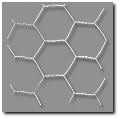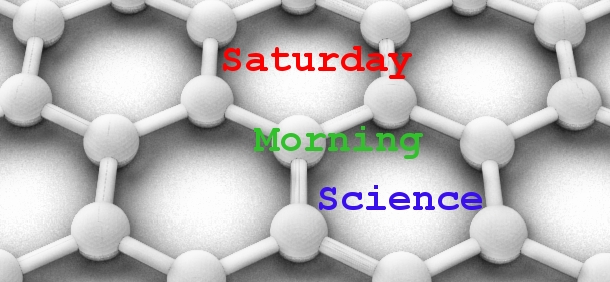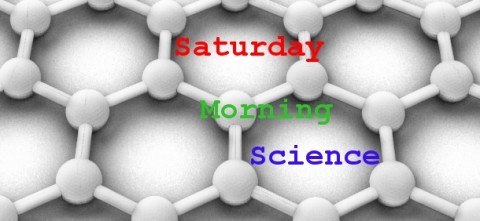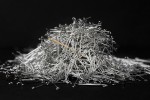Saturday Morning Science 003
Graphene Novelties– This week’s edition started off with a simple article from Science Daily: Graphene and ‘Spintronics’ Combo Looks Promising. A group of researchers from the City University of Hong Kong and the University of Science and Technology of China presented their work on using graphene as a platform for creating “spintronic” devices. In their scheme, the electromagnetic spin of particles, their “up” or “down” orientation, could be used to encode the ones and zeroes of binary data at incredibly high density (seeing as graphene is one atom thick) and stability (owing to the fact that no charge is necessary for the particles to retain their spin).
Reading the piece made me aware of my ignorance about graphene. I knew that the 2010 Nobel Prize in Physics had been awarded to two graphene researchers but it was just a simple blurry factoid. To me, graphene was yet another neat thing that carbon can do; just like life itself. The Science Daily article tossed around specs that caught my jaded eye; strength 200 times greater than steal and conductivity 100 times faster than silicon and all of this at room temperature. It seems like something that a pulp-era super-scientist would come up with to defeat the alien invaders and save the world except for the fact that it’s real. So what is this stuff and what are people doing with it?
 Two Dimensional Atomic Chicken Wire- That’s about the simplest way of describing graphene. Technically, it’s an allotrope of carbon, allotropes are molecular variants of a given element, the most famous allotrope of carbon would be diamond but one of it’s more common forms, graphite ( the “lead” in the common pencil) is the source for graphene. It’s “two dimensional” in that being one atom high it’s as close to that condition as anything can physically be and not be just a mathematical abstraction. Imagine a hexagonal grid so thin that if 3,000,000 sheets of it were layered like paper the resultant stack would be 1 millimetre thick. First described by Hanns-Peter Boehm, in 1962, ( although ultra thin sheets of graphite were revealed by electronic microscopes in 1948) it was the work of English and Russian researchers in 2004 that brought to light its electrical and physical properties.
Two Dimensional Atomic Chicken Wire- That’s about the simplest way of describing graphene. Technically, it’s an allotrope of carbon, allotropes are molecular variants of a given element, the most famous allotrope of carbon would be diamond but one of it’s more common forms, graphite ( the “lead” in the common pencil) is the source for graphene. It’s “two dimensional” in that being one atom high it’s as close to that condition as anything can physically be and not be just a mathematical abstraction. Imagine a hexagonal grid so thin that if 3,000,000 sheets of it were layered like paper the resultant stack would be 1 millimetre thick. First described by Hanns-Peter Boehm, in 1962, ( although ultra thin sheets of graphite were revealed by electronic microscopes in 1948) it was the work of English and Russian researchers in 2004 that brought to light its electrical and physical properties.
At first I thought that graphene extractaction was not likely to show up as a DIY article in Make magazine any time soon but the Nobel prize winners had used Scotch tape to collect the samples that they used in their research. Graphene is very common. Draw a line with a graphite pencil and you’ve produced hyperbolic “tonnes” of it.
Graphene’s Greatest Hits-Researchers in a wide variety of fields have shown interest in graphene:
Biology and Medicine: It’s size and chemical properties could make it key component in atomic level detection and manipulation devices for diagnosis and single molecule gene sequencing. At more human scale, graphene is being investigated for use as surgical tape and anti-bacterial food wrap.
Electronics: Silicon is nearing its maximum capacity for miniaturisation. Graphene based transistors are already being designed and IBM scientists, when not teaching computers to win at Jeopardy, have announced that they have the first working model. Add to this graphene’s 2D structure and you have a great platform for flexible circuits. The focus on graphene naturally creates competing technologies with similar but different properties. For example, there is promising work being done using molybdenite
Batteries and Solar Cells– A high surface to mass ratio puts graphene in the range of a ultracapacitor when used as a conductive plate. It is also a good candidate for schemes involving battery production using conventional printing techniques on biodegradable paper. Similar techniques could also used to make printable sheets of solar cells.
 Aviation and Space Travel– In 1670 the Jesuit priest, Francesco Lana de Terzi proposed the concept of a lighter than air vehicle using a contained vacuum to produce lift. The only snag in the scheme is the simple fact that no material is strong enough to withstand the normal atmospheric pressure surrounding the contained vacuum and still be light enough to be airborne. If graphene were used to make the balloon’s skin, it has been estimated that a vacuum balloon built to the size of the largest zeppelin could lift 80,000 tonnes (the soon to be obsolete space shuttle’s payload limit is 14 tonnes). Its final maximum altitude would be just short of the edge of space.
Aviation and Space Travel– In 1670 the Jesuit priest, Francesco Lana de Terzi proposed the concept of a lighter than air vehicle using a contained vacuum to produce lift. The only snag in the scheme is the simple fact that no material is strong enough to withstand the normal atmospheric pressure surrounding the contained vacuum and still be light enough to be airborne. If graphene were used to make the balloon’s skin, it has been estimated that a vacuum balloon built to the size of the largest zeppelin could lift 80,000 tonnes (the soon to be obsolete space shuttle’s payload limit is 14 tonnes). Its final maximum altitude would be just short of the edge of space.
Another concept that graphene could profitably explore is the use of the of the Casimir Effect. Closely bound to the concept of zero-point energy , the Casimir Effect is an attractive or repulsive force produced in the space between two unchanged metallic plates in a vacuum. The effective space is only a few atoms wide and theoretical work has started on using silicon arrays to generate propulsion for space craft. Higher and more efficient energy yields might be possible with graphene. I’ll stop here, the Casimir Effect has also been proposed as a catalyst in artificial wormhole creation but I think graphene has enough potential uses for now.






682452 403724Most beneficial gentleman speeches and toasts are produced to enliven supply accolade up to the wedding couple. Newbie audio system the attention of loud crowds ought to always think about typically the wonderful norm off presentation, which is their private. greatest man speaches 724429